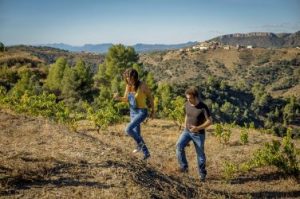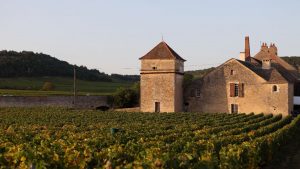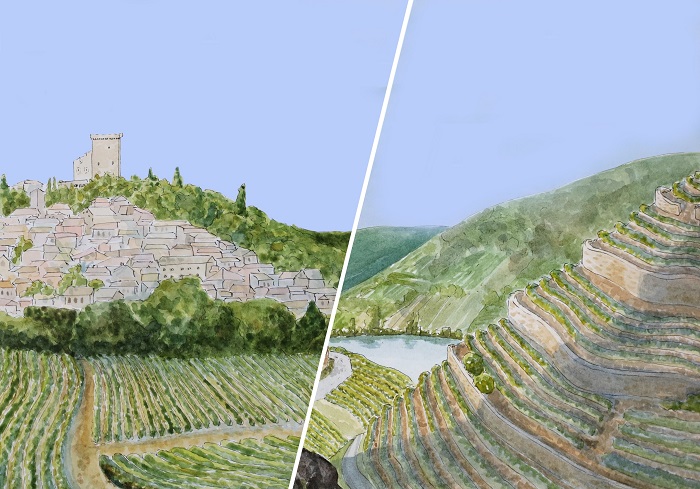
Côte-Rôtie vs Châteauneuf-du-Pape – What’s the difference? Though both appellations are a part of the Rhône Valley, they differ in several notable ways. Let’s break down what sets them apart and shapes their individuality.
First, let’s sketch out the basics of these legendary wine giants.
The Côte-Rôtie, situated in the northern part of the Rhône Valley, is a two-thousand-year-old winemaking area, crafted entirely by human hands on steep slopes. Today it is widely recognised as one of the region’s most prestigious appellations, yet it was nearly wiped out by the phylloxera outbreak and both world wars, shrinking to just around forty hectares. It’s thanks to iconic winemakers such as Etienne Guigal that the region regained its former glory little by little. Nowadays, wines are produced in a vineyard split between the Côte Brune – schist soil and dense, mineral wines – and the Côte Blonde – gneiss soil and airy, lively wines – in communes such as Ampuis, Saint-Cyr-sur-Rhône and Tupin-et-Semons.
Châteauneuf-du-Pape , located in the southern part of the Rhône Valley, was named after the popes’ summer residence in Avignon, in the days when they lived in France. In fact, we owe them a debt of gratitude for making the region’s wines such an international success. This prestigious appellation is where the concept of AOC (Appellation d’Origine Contrôlée) originated in 1923. The wines are crafted from vineyards located within the village of Châteauneuf-du-Pape itself, as well as those in neighbouring Orange, Sorgues, Courthézon, and Bédarrides.
Let’s turn our attention to the specific characteristics of each of these appellations.
The climate
Côte-Rôtie enjoys a semi-continental climate with Mediterranean influences. This means hot, sunny summers, mild autumns, and harsh winters, with a biting cold often brought by the northerly winds known as la bise.
In contrast, Châteauneuf-du-Pape enjoys a Mediterranean climate. The vines are swept and refreshed by the powerful mistral wind, and the region is one of the driest and sunniest in the Rhône Valley. The year here is shaped by two dry seasons, hot summers and cold winters, and two wetter periods, during spring and autumn.
The soils
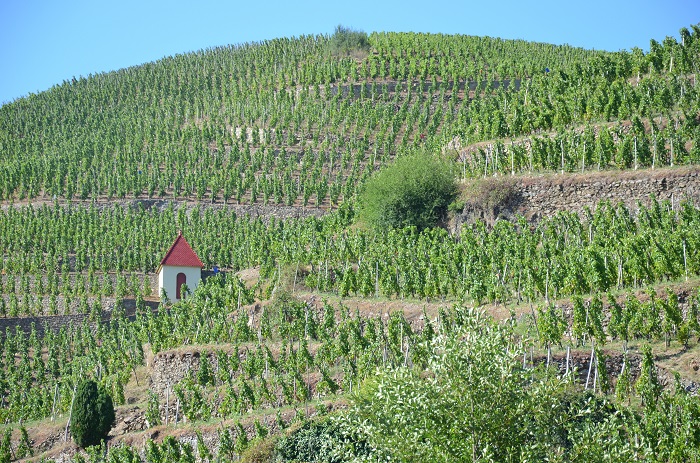
The Côte-Rôtie vineyard is instantly recognisable by its terraced hillsides, known as chayets (chaillets or chaillés), which are supported by stone walls called cheyx. The vines draw the nutrients they require to flourish from gneiss, clay, granite and iron oxide soils, and are oriented towards the south and south-east. This perfect exposure to sunlight is reflected in the appellation’s name, Côte-Rôtie quite literally meaning roasted slope.
The Châteauneuf-du-Pape terroir is more complex. Let’s keep it simple and categorise it into three types. These include gravel soils, sandy soils, and the renowned terraces of galets roulés (rolled pebbles). These pebbles act as thermal regulators, absorbing the sun’s heat during the day and releasing it during the cooler nights, keeping the vines warm. In truth, there’s no significant qualitative difference between these terroirs, each can produce exceptional wines.
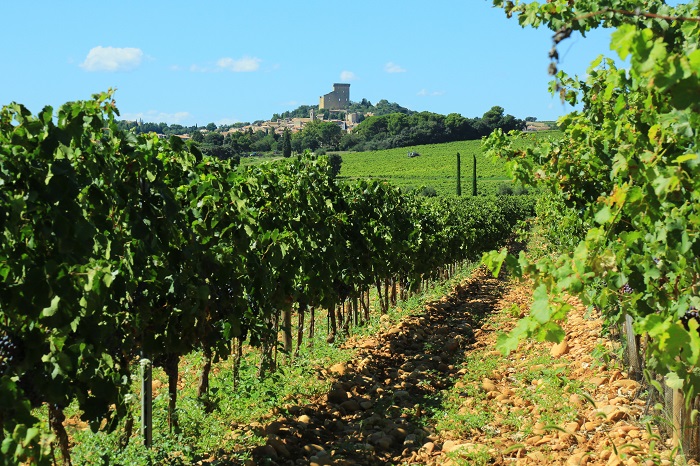
The grape varieties
Once again, north and south differ.
In Côte-Rôtie, Syrah almost reigns supreme. While most estates focus on producing single varietal wines, some opt for a skilful blend of Syrah with Viognier. When cultivated in complantation of up to 20%, the latter adds suppleness and fruitiness to the wine. You may also find some Petite Serine, an ancient variety of Syrah, in some blends.
As for Châteauneuf-du-Pape, it is renowned for its thirteen grape varieties, including Grenache, Syrah, Mourvèdre, Cinsault, Muscardin, Counoise, Clairette, Bourboulenc, Roussanne, Piquepoul, Picardan, Vaccarèse, and Terret Noir.
In the vineyard
As we mentioned earlier, the Côte-Rôtie AOC spans 230 hectares, with vines planted on particularly steep terraces, making mechanised work difficult, if not impossible. As a result, working by hand, on horseback or using a winch is the norm. The vines themselves are supported by an échalas, a sturdy post made from chestnut, pine, or acacia wood, deeply anchored into the ground. This ensures the vines remain stable, receive optimal sunlight, undergo effective photosynthesis, and reach ideal ripeness.
Châteauneuf-du-Pape spans 3,200 hectares, and here you’ll notice vines pruned in the traditional gobelet style (recognisable by their lack of trellising, they resemble small bushes). The foliage helps protect the grapes from sunburn. Unsurprisingly, harvests are done by hand. Syrah, which was introduced more recently to the region, is pruned using the Guyot method and is trained on wires.
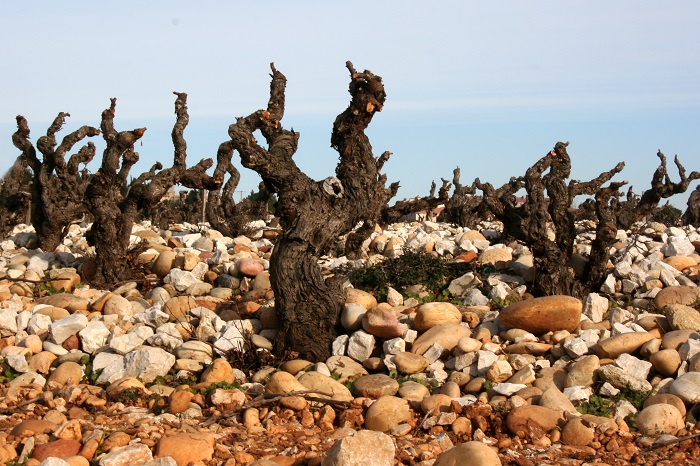
In the winery
In Côte-Rôtie, if Viognier is used, it is co-fermented with Syrah. Local wines are known for being austere and powerful in their youth, so estates favour extended ageing, typically between one to three years, before releasing them to the market.
Due to the very hot summer climate, Châteauneuf-du-Pape wines are predominantly blends, crafted to achieve a harmonious balance between alcohol and tannins. However, it’s not uncommon to find beautifully crafted single-varietal wines. The reds are aged in foudres (large wooden barrels), concrete vats, barriques (smaller barrels), or demi-muids (600-litre barrels). In fact, using different sized containers is common practice. To preserve a certain freshness in the Châteauneuf-du-Pape white wines, they are matured in inert containers such as stainless steel or concrete vats, which ensure that the primary aromas are retained. Others may seek additional complexity (think vanilla, almond and sweet spices) by using oak casks or demi-muids.
Different types of wines
It’s a fact; red wines are the hallmark of Côte-Rôtie. These wines are sought after for their intense, almost black colour with garnet reflections, from which emerges a very complex aromatic bouquet. You’ll find notes of red fruits (raspberry, cherry, strawberry) and black fruits (blackcurrant, blackberry), along with floral hints (violet), spices (pepper, liquorice, cinnamon), and, with age, earthy tones, tobacco, and cocoa. On the palate, you’ll appreciate their boldness, concentration and depth, structured by fine tannins that deserve to mellow in the cellar for at least 15 years. Finesse and elegance are the watchwords here.
In contrast, Châteauneuf-du-Pape produces both red and white wines. The reds display a deep ruby hue with purple hints. The nose is imbued with aromas of red and black fruits, sweet spices, roasted notes (coffee, cocoa), musk, and game. On the palate, the wine is dense, fleshy, and defined by a fine tannic grain. As for the whites, they are by no means lacking in richness. This is evident from the thick disk surrounding their pale gold hue with green reflections. Bursting with delicate aromas (white flowers, citrus, white-fleshed fruits, tropical fruits, honey), this white wine charms all who taste it with its roundness and a sometimes toasty finish (vanilla, dried fruits), a clear sign of oak ageing.
How to serve the wines?
As a general rule, Côte-Rôtie and Châteauneuf-du-Pape red wines age beautifully. Depending on the wine, we recommend waiting at least 15 years for the former and 20 years for the latter. Both are best enjoyed at room temperature, around 16°C, after being decanted.
There’s no need to wait so long to savour a Châteauneuf-du-Pape white, which, thanks to its richness, can be served slightly chilled at 13°C. Decanting is also recommended.
Food pairings
The power, precision and elegance of Côte-Rôtie red wine deserves an equally noble pairing, such as roasted red meats or game.
A Châteauneuf-du-Pape red, with its generosity and opulence, works wonders with rich, dishes with sauce, truffle-infused creations, or dishes prepared with a variety of mushrooms. As for the whites – full-bodied, flavourful, and persistent – they pair beautifully with equally indulgent dishes such as salmon (either tartare or gravlax), lobster, ravioli, white meat, risotto, or authentic spaghetti carbonara.
Some iconic estates
Côte-Rôtie
Among our partner producers:
- Guigal
- Jamet
- René Rostaing
- Stéphane Ogier
- Yves Gangloff
- Jean-Michel Stephan
- Clusel Roch
- Jean-Michel Gerin
- Marie et Pierre Benetière
- Vignobles Levet
- Othéguy
- Pierre Gaillard
- Jasmin
- Georges Vernay
- François Villard
- Monteillet
- Bonserine
Other reputable estates: Marius Gentaz-Dervieux, Dervieux Thaize
Châteauneuf-du-Pape
Among our partner producers:
- Château de Beaucastel
- Domaine du Pégau
- Clos des Papes
- Clos Saint-Jean
- Giraud
- La Janasse
- La Barroche
- La Mordorée
- Le Vieux Donjon
- Les Cailloux André Brunel
- Saint-Préfert
- Beaurenard
- Charvin
- Domaine de Marcoux
- La Vieille Julienne
- Santa Duc
- Vieux Télégraphe
- Mas Saint-Louis
Other reputable estates: Clos du Mont-Olivet, La Gardine, Jean-Pierre & Thierry Usseglio
All wines from Côte-Rôtie for sale

